The other three appeals are of the appellants (in connected appeals), who were also candidates for the post of Civil Judge (Junior Division) for the year 2013 in the State of Himachal Pradesh, and have also challenged the selection process as well as the appointment of the present appellants, though for different reasons. The preliminary examination for these posts was held on 12.05.2013 of which the results were declared on 15.06.2013. The candidates, who had qualified preliminary examination participated in the main written examination which was held between 15 July, 2013 to 18 July, 3 2013. Eighty candidates qualified in the written examination and were ultimately called for the interview, which was held on 07 and 08 October, 2013. After the publication of the results for the eight vacancies on 08.10.2013, as referred above, an exercise was evidently undertaken at the level of the State Government, where an information was sought from the Registrar General of the Himachal Pradesh High Court as to the correct position of existing vacancies in the state judicial service in the cadre of Civil Judge (Junior Division). Sir, I am directed to refer to the subject cited above and to enclose herewith a copy of letter Number3- 50/2012-PSC(E-I) dated 11 October, 2013 received from Secretary, HP Public Service Commission vide which select list of 08 candidates (06 against clear cut and 02 against anticipated vacancies) for the 5 appointment as Civil Judge (Jr. With reference to your letter No Home-B(B)6/2006-VI-6-74 dated 19.10.2013, on the captioned subject, I have been directed to inform you that the existing vacancy position in the cadre of Civil Judge (Junior Division) is as under:- Sr .
A meeting was meanwhile held at the State level on 21.10.2013 to discuss the selection of Judicial Officers in the ongoing process of 2013 and the number of vacancies on which such selection could be made. As we can see, in the said meeting, officers nominated by the Government of Himachal Pradesh, State Public Service Commission and the High Court of Himachal Pradesh were present. Public Service Commission will publish a revised Select List of the candidates from the year 2010 merit list by including 2/3 of the actual and anticipated vacancies. The category-wise break up of vacancies is as under: – Clear Cut Vacancies: – 06 (General-01, SC-01, ST-02 & OBC-02) Anticipated Vacancies: – 02 (General)
On completion of the recruitment process of H.P. Judicial Service Examination, 2013 for filling up of the above mentioned vacancies, the H.P. No Roll No Name of the Candidate Category Against Clear Cut Vacancies 1 1025 Ms. Tribe Category) can be kept in the select list as no other candidate from OBC category had qualified the HPJS Examination – 2013. Tribe Category) candidates in the select list and the Commission should publish the select list accordingly.” In Shweta Dhingra (supra) the Division Bench of the Himachal Pradesh High Court was dealing with the selection of Civil Judge (Junior Division) in the State for the year 2010, and it was of the opinion that apart from clear and anticipated vacancies, the Commission should prepare a select list of some additional candidates. Still further, it is directed that the select list should be published in the order of merit and should be double of the vacancies notified.
Unfortunately, the select list published by the Public Service Commission was only for the clear cut vacancies of five and three anticipated. It is informed that the select list happened to be limited to the clear cut vacancies and actual number of anticipated vacancies in view of the directions already issued by the Government in 2008-09. Since the select list is to be published by the Public Service Commission, there will be direction to the High Court, Government and the Public Service Commission to jointly take up this exercise of preparation of select list immediately after the publication of the merit list and this exercise shall be completed within two weeks of the publication of the merit list, every year. The first direction is regarding the additional vacancies, which were to be 2/3 of the actual and anticipated vacancies and second direction was the joint exercise to be undertaken by the State Commission, State Government and the High Court in determining and filling these vacancies. I am directed to refer to the letter
No
3- 50/2012-PSC(E-1) dated 11 October, 2013 on the subject cited above and to say that as per this Department requisition 8 (eight) posts of Civil Judge (Jr.
14 Keeping in view of above position you are requested to sponsor three more candidates from the select list against roster point 55, 56 & 11 from the unreserved category at the earliest.”
Ultimately, however, only two names from the general category who were next in the order of merit were made available for the select list which were of Vivek Kaisth and Akansha Dogra (appellants before this Court), who were recommended for appointment as Civil Judge (Jr. The main purpose for the directions given by this Court in Malik Mazhar was to timely fill judicial vacancies in the States.
(c) Future vacancies that may arise due to promotion, death or otherwise, say ten per cent of the number of posts.” 16 The third category which was the “future vacancies”, that may come due to reasons other than retirement, were to be 10% of the cadre strength, as this was clarified in the judgment. As far as (a) existing vacancies and (b) future vacancies which were to come within one year due to retirement were concerned, there was no difficulty in anticipating these vacancies.
Public Service Commission, (2008) 17 SCC 703 : (2010) 1 SCC (L&S) 942], this Court had given certain directions regarding the selection and appointment of members of the subordinate judicial officers in various courts. Public Service Commission, (2008) 17 SCC 703 : (2010) 1 SCC (L&S) 942], this Court directs that in future the High Courts/PSCs shall notify the existing number of vacancies plus the anticipated vacancies for the next one year and some candidates also be included in the wait list. Therefore, the directions given by the Division Bench of the Himachal Pradesh High Court in Shweta Dhingra (supra) in our opinion, were not necessary, and the reliance upon these directions by the three- member Committee in the present case were misplaced since the ‘vacancies’ had already been advertised. All the same, even if there is an apparent dichotomy between what the Service Rules suggest and what is mandated by this 22 Court in Malik Mazhar this must be resolved by making a harmonious interpretation between the Service Rules and Articles 14 and 16 of the Constitution of India, as held by this Court in High Court of Kerala v.
Hence, a significant field in regard to the 23 process of selection and appointments to the judicial services is not covered by the decision in Malik Mazhar (3) Public Service Commission, (2008) 17 SCC 703] for which one has to fall back upon construing the rules governing the State Judicial Service in question.” In Malik Mazhar, this Court had dealt with any probable conflict of duties on interference with the independent functioning of State Commissions where it reiterated its sole purpose of timely filling up of judicial vacancies. (supra) while dealing with a situation where there was an almost similar dichotomy between the Kerala Judicial Service Rules and the directions given in Malik Mazhar, this Court was of the opinion that in such cases, it is better to seek harmony between the two and held that “ A better line of approach is to seek an interpretation which will bring harmony between them. Indeed, a literal interpretation of sub-rule (2) of Rule 7 would give a right of consideration to the petitioners who were before the Kerala High Court, but that would be against service jurisprudence as that would amount to making appointments on vacancies which were not advertised, vacancies which came up after the notified date on which would also rest the claim of such candidates who gained eligibility subsequently and had a right of consideration.
The submission of the appellant is that a literal interpretation of Rule 7(2), without reference to the constitutional requirement of not operating a select list beyond the notified vacancies, would render the Rule violative of Articles 14 and 16 and such an interpretation should be avoided. The answer to this submission, which has been proffered by the respondents is that under Rule 7(1) a probable number of vacancies is required to be notified and since an exact number is not notified, there is no constitutional bar in exceeding the 37 probable vacancies that were notified in 2019. (Thomson Reuters West, 2019).The definition of “Probable” in the 4th Edn., Revision 6 (1971) of the Black’s Law Dictionary was:“Having the appearance of truth; having the character of probability; appearing to be founded in reason or experience…; having more evidence for than against; supported by evidence which inclines the mind to believe, but leaves some room for doubt; Apparently true yet possibly false.”] defines the expression “probable” as: “Probable : likely to exist, be true, or happen” “Probable number of vacancies”, as we have seen, is based on computing the existing vacancies and the vacancies anticipated to occur during the year. Candidates who become eligible for applying for recruitment during a succeeding year of recruitment would have a real constitutional grievance that vacancies which have arisen during a subsequent year during which they have become eligible have been allocated to an earlier recruitment year. Appointments cannot be made over and above the vacancies which have been advertised, except in an emergency situation or for some unforeseen reasons, in public interest or when a policy decision is taken by the State Government in this regard, as held by this court in Gujarat State Dy.
4 SCC 377, this Court had held that Public Service Commission cannot recommend more names than what have been advertised and any appointment, which is made in excess to the vacancies, which have been advertised would be arbitrary. The purpose of a waiting list is that when selected candidates are unable to join the 30 post for any reason whatsoever, the post should not remain vacant and this shortfall of candidates can be met from the candidates who are in the waiting list. A waiting list prepared in service matters by the competent authority is a list of eligible and qualified candidates who in order of merit are placed below the last selected candidate. or for any other reason within the period the list is to operate under the rules or within reasonable period where no specific period is provided then candidate from the waiting list has no right to claim appointment to any future vacancy which may arise unless the selection was held for it. It is operative only for the contingency that if any of the selected candidates does not join then the 32 person from the waiting list may be pushed up and be appointed in the vacancy so caused or if there is some extreme exigency the Government may as a matter of policy decision pick up persons in order of merit from the waiting list. The constitutional discipline requires that this Court should not permit such improper exercise of power which may result in creating a vested interest and perpetrate waiting list for the candidates of one examination at the cost of entire set of fresh candidates either from the open or even from service.” This was reiterated by this Court in Surinder Singh & Ors.
We are referring to the position of law on “waiting list” because one of the arguments of the appellants (in connected appeals) before us is that, since in any case there was a direction in Malik Mazhar-2 for having a “waiting list”, therefore the names of those two appellants ought to have been considered as names from the “waiting list”. The vacancies on which the appointments have been made could not be anticipated 34 at the time of advertisement (February 1, 2013), and hence these vacancies were not advertised. Vacancies which could not be anticipated before the date of advertisement, or the vacancies which did not exist at the time of advertisement, are the vacancies for the future i.e., next selection process. Respondent No.4 (Shri Kuldeep Sharma), who was also one of the candidates, in the merit list of candidates along with the appellants, obviously did not question the existence of these two vacancies but only that these vacancies ought to have been advertised along with the initial 8 vacancies. The High Court has allowed the writ petition filed by respondent No.4 to the extent that it held that the appointment of the appellants was in violation of the law in as much as they were not appointed either on the existing vacancies or anticipated vacancies but they were appointed on “future vacancies” which were never advertised. In the preceding paragraphs of the present order, we have already clarified the position of law and therefore, in our opinion, the High Court was right in holding this position, which is the settled position of law. The same question was there before the High Court and it expressed its inability to protect the appointment of the appellants for two reasons. 4 and 6 by the petitioners herein, whose rights are equally important as that of the aforesaid respondents and, in case respondents Nos. What the High Court never answered was as to how much of this blame of “illegal” selection and appointment would rest on the High Court (on its administrative side). The additional affidavit filed by the Registrar General of the High Court before the Division Bench of the High Court says that these appointments were not made in consultation with the High Court.
These judicial officers now have a rich experience of 10 years of judicial service behind them. (2023) SCC OnLine SC 994 though the finding arrived at by this Court was that the Rules of the game were changed by the High Court of Kerala by prescribing minimum marks for the viva voce, which were not existing in the Rules and therefore in essence the appointment itself was in violation of the Rules, yet considering that those persons who had secured appointments under this selection have now been working for more than 6 years it was held that it would not be in public interest to unseat them. While the grievance of the petitioners is that if the aggregate of marks in the written examination and viva-voce were taken into account, they would rank higher than three candidates who are respondents to these proceedings, equally, we cannot lose sight of the fact that all the selected candidates are otherwise qualified for judicial office and have been working over a length of time.
Case Title: VIVEK KAISTH Vs. THE STATE OF HIMACHAL PRADESH
Case Number: C.A. No.-006233-006234 / 2023



